Meet the golf course manager: Grahame Taylor
Related Articles
Perhaps the most exciting golf development of 2020 will be a stunning new links course near St Andrews, which will open this year. Here, its course manager talks about the work that has gone into creating the venue.
Dumbarnie Links, Scotland’s newest links golf course, crafted by former Ryder Cup player Clive Clark, is expected to open for play this May. The course, located in Fife along the north shore of the Firth of Forth, is built upon land that is part of the historic Balcarres Estate. It is 345 acres of genuine sandy links.
“There was an air of uncertainty when my family was first approached about building a golf course on our land,” said Lord Anthony Balniel. “Fast forward several years and we simply could not be more pleased. I have been struck not only by the beauty of what has been created with the dune landscape significantly enhanced but also by the focus on the wildlife, plants and birds. It has been a joy to see the project unfold.
“Dumbarnie Links has already received rave reviews from not just the local community, but internationally, as well. When we began this ambitious undertaking, our goal upon completion has always been to provide an unparalleled, memorable golf experience – not just the playing surface, but the service level, as well. I think we’re well on our way to achieving that.”
We caught up with the club’s course manager, Grahame Taylor, to find out about how the new course has been built and the major role the greenkeeping team has been playing in this exciting project.
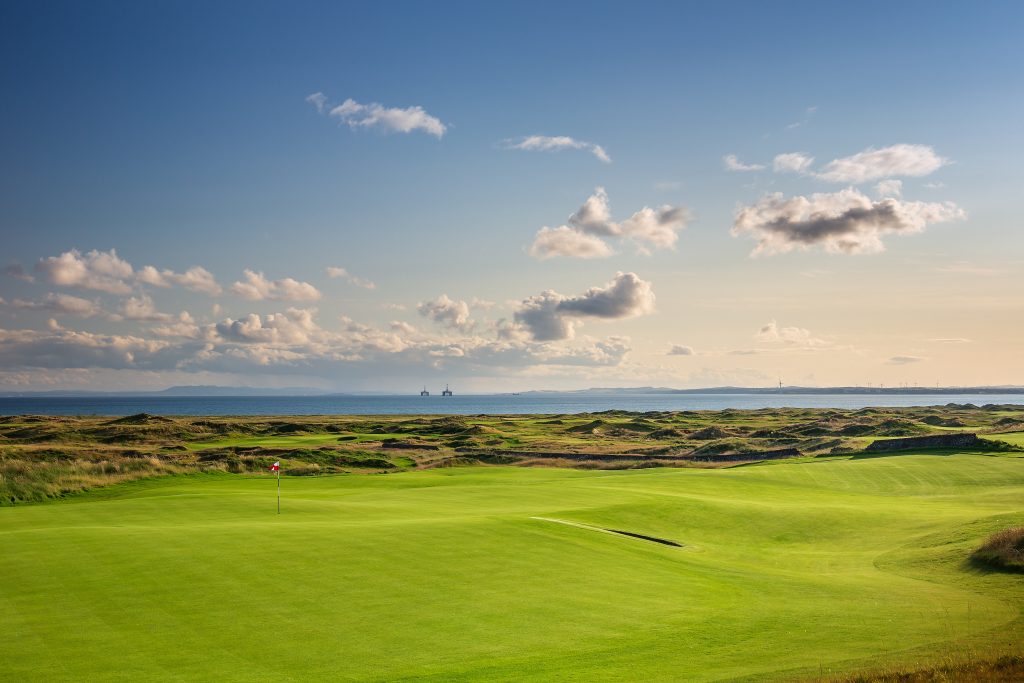
Before we get onto Dumbarnie Links, can you outline your career path to this position?
My greenkeeping career started in 1995 at my home course, Leven Links. I worked at Leven until 2008 when I left to work in Murcia, Spain. I worked in Murcia for two years; this was a great life experience and for my career as I experienced the challenges of working with warm season paspalum grasses.
In 2010 I returned to the UK and worked at Gleneagles for four years leading up to the 2014 Ryder Cup. Following the 2014 Ryder Cup, I moved to St Andrews Links where I worked on the Castle Course, New Course, Jubilee Course and then finally on the Old Course as supervisor.
I started at Dumbarnie as course manager in June 2018.
I completed all my studies in golf course management at SRUC Elmwood College in Fife.
With the course not yet opened, what is the size of the greenkeeping team at the moment?
Our grow-in team is currently 13 guys. They are all very competent greenkeepers and complement each other well. This number will continue to grow in spring as we move into full operation mode.
I like every team member to be able to carry out all tasks. This not only allows for job variation but also makes daily work plans to be far more flexible.
The construction and grow-in of a golf course is a unique experience with many projects that have lasted for several weeks, meaning for consistency and efficiency the same staff have worked on these projects, until completed.

How did you select them, what support and training have you set in place for development and how would you describe your management style?
Being able to build a new team from scratch has been great. When looking for a new member of the team I am simply looking for someone with a great attitude and passion, and a good personality that will work well within a team. I believe we can teach the skills required and supply training as needed.
We have a highly experienced and motivated team at Dumbarnie and they work very well together.
I do not believe in micro managing the team. I like to show trust in my team members to carry out their tasks. I encourage my team to use their own initiative and I feel very proud of the them and the standards they are achieving.
What would you say are the biggest challenges you’ve faced during the grow-in and did these impact on the overall project?
The biggest challenge of the grow-in was the high winds during the spring of 2019. The course is built with the fine sands indigenous to the property. We have wall-to-wall irrigation allowing us to control all the playing surfaces. However, the dunes were more difficult to germinate any seed on, meaning there was no stabilisation in those areas for longer periods of time. This was a difficult stage that lasted a few months, but the agronomy team always rose to the challenge and were great being proactive, constantly building protective fences to limit any damage.
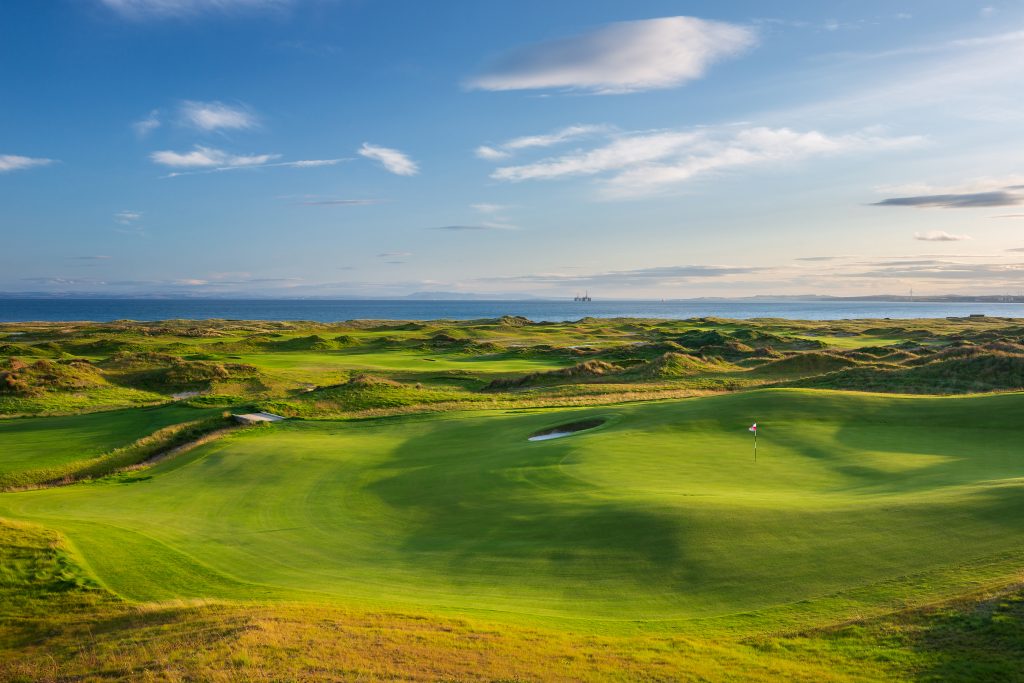
There are few world-class courses able to offer such an expanse of beach and water frontage as Dumbarnie Links has been blessed with. What challenges will this present to the future daily maintenance of the course and what measures have you put in place to reduce foreseeable problems?
It’s true that the design of the course from Clive Clark has allowed sea views from every hole on the course, something us locals can take for granted.
Coastal erosion is something we will monitor closely. We have already taken part in joint projects with the Fife Coast and Countryside Trust along the coastal dunes and will be carrying out more projects with them in the future.
The bunkering is a half-and-half mixture of traditional sod-stacked bunkers along with what could be described as natural bunkers surrounded by tall fescue. What was the inspiration for these, what technology and materials have been used for construction and how do you see this impacting on the future management they will require?
We have 142 bunkers, 50 per cent revetted and 50 per cent natural style. The revetted bunkers were built by EcoBunker and will stand far longer than a conventional sod-stacked bunker. These have turned out great with fescue seed germinating on the faces making them look natural.
The longevity of the EcoBunker does promote sustainable greenkeeping, allowing us to concentrate on other projects for the next few winters. The natural bunkers are simply large areas carved into the dunes almost like sand blowouts, giving an authentic look to the course.
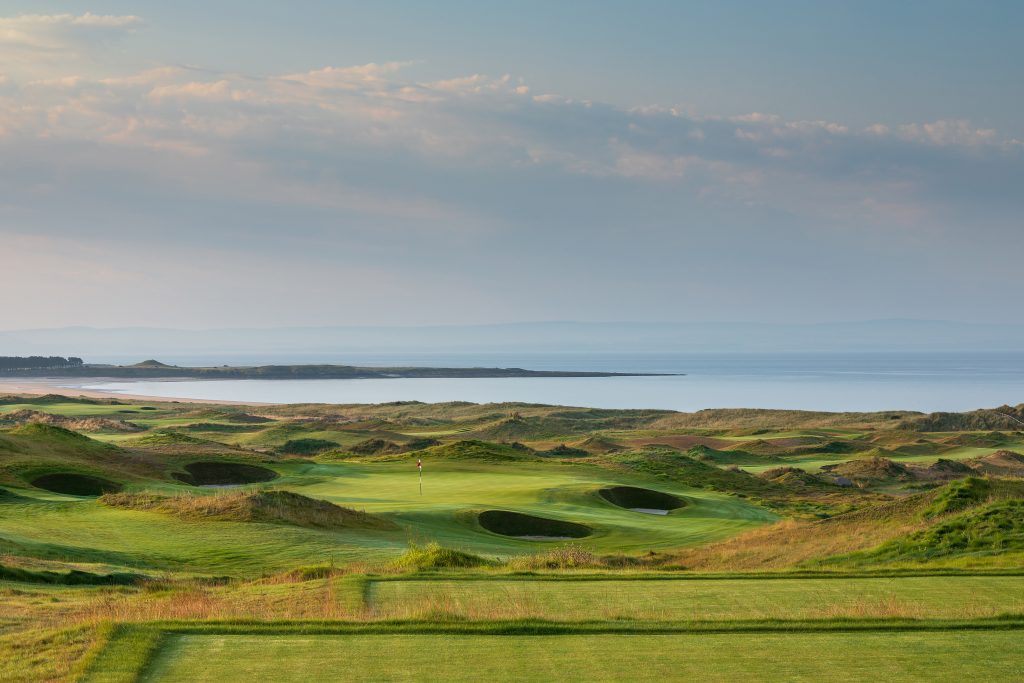
This part of the Balcarres Estate was mostly grazing farmland. How has the course landscape been developed to provide desirable habitat for species and protect growth and ecology for the future?
We have 167 hectares of which 27 per cent of that land is maintained playing surfaces. This has allowed us to create some very large areas dedicated to wildlife including a large wetland / pond and sand scrape areas. To see these areas improve with new habitats and species so quickly has been rewarding and something we intend to develop further.
Praise has been heaped on the shaping, the strategy and fine grasses of the course. Please can you give a little more insight as to how this came about and what the ultimate objectives are?
During construction, 600,000m3 of dirt was moved in 12 weeks to create 600 dunes, transforming the property. Many tee complexes have been pushed up high, facing the sea and taking full advantage of the views.
There are many risk-and-reward holes, making Dumbarnie a really fun course to play. It was very evident during construction that Clive Clark wanted to create a golf course for all golfing abilities to enjoy.
Dumbarnie Links has set up a preferred supplier agreement to use John Deere equipment across the course, what were the reasons for selecting John Deere?
Dumbarnie Links is looking to produce high quality playing surfaces for all our customers to enjoy. I believe the quality of John Deere equipment matches our own high standards, allowing us to work successfully together.
You and your team are working in partnership with the Double A dealership team. How has this been of benefit, what have you experienced and how would you describe your relationship with Double A?
The Double A team have been excellent support for Dumbarnie during the grow-in phase of the project. We were supplied with a grow-in fleet of mowers which has been a great help to us. Their proximity of nine miles from our property means back-up support has been second to none.
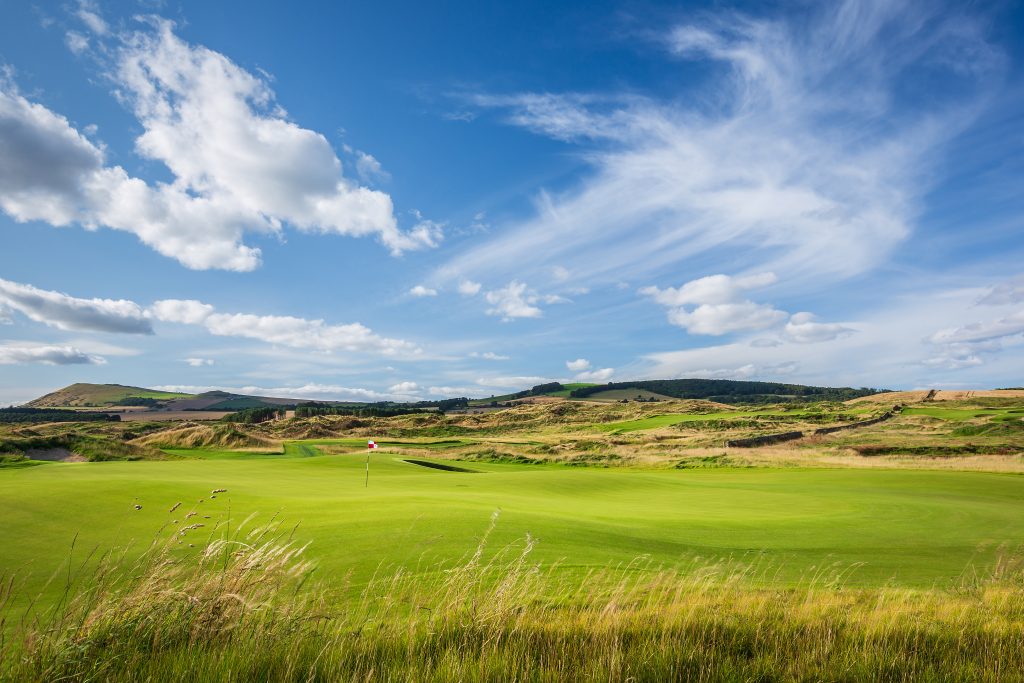
What height of cut will you use across the course?
Greens will depend on wind speeds on any given day although the undulations are very fair, but around 5mm should produce the desired speeds.
Surrounds, tees and fairways will all be the same height of 8mm.
I believe if all these surfaces can blend into one it gives a nice links feel to the course.
What do you think are the strengths that have carried you through your career and current position at Dumbarnie Links and how do you look forward to keep your passion high and the course evolving?
I have always had a passion for the course that I am working on, and take great pride in my work. There is great job satisfaction in producing a well-presented golf course and also very rewarding to see the customers enjoying playing the course.
Being on site from the very beginning at Dumbarnie has been a fantastic experience for me. I have been very determined pushing the project forward to make sure we are ready for [the opening date] May 16, 2020.
I was delighted to be appointed as course manager at Dumbarnie.
This is a once-in-a-lifetime opportunity for me, especially so close to home.
I have embraced this exciting opportunity from day one and I for one cannot wait to see the course open for play in May 2020.
You’ve purchased two Tru-Turf rollers for the course, what is it that particularly appeals to you about this roller?
The R50 model is now wider at 50 inches and also has the overlapping heads, this allows us to roll the surfaces more efficiently, also the brushes on the rollers are a great help at keeping the surfaces free of any debris.
What cultivars have you selected to use across the various areas of the course, what results have you seen to date and what are your expectations for a more established course in five years and more?
Most of the surfaces are dominated with slender creeping red fescues and chewings red fescues. The decision was made to add Charles browntop bent at the very beginning to our greens and surrounds making up 15 per cent of the sward. This was to create a denser sward and allow for more flexibility with mowing patterns and green speeds.
The agronomy team sowed the greens and surrounds in August 2018 and we were cutting them at 15mm 11 days later. I have been delighted with the surfaces at this very early stage and they can only improve further in the next three to five years as they mature.
The walkways are very narrow at four paces wide so they were sown out with perennial ryegrass to be able to cope with heavy foot traffic.
You mentioned that the indigenous sand across the course is inert, what fertiliser programme will you be introducing and how will you apply this to encourage stronger root growth and plant stability?
I love the fact we used indigenous sand from the property making us a true links course. The sand had 0.4 per cent organic matter meaning grow-in fertiliser programmes were all organic based with lots of micro-nutrients. To grow a course in proved to be so different from routine maintenance. I was very aggressive with our programmes to establish all the playing surfaces quickly, knowing we could dial programmes back down once established. Very high percolation rates can been challenging but this is improving with the root mass increasing throughout 2019.
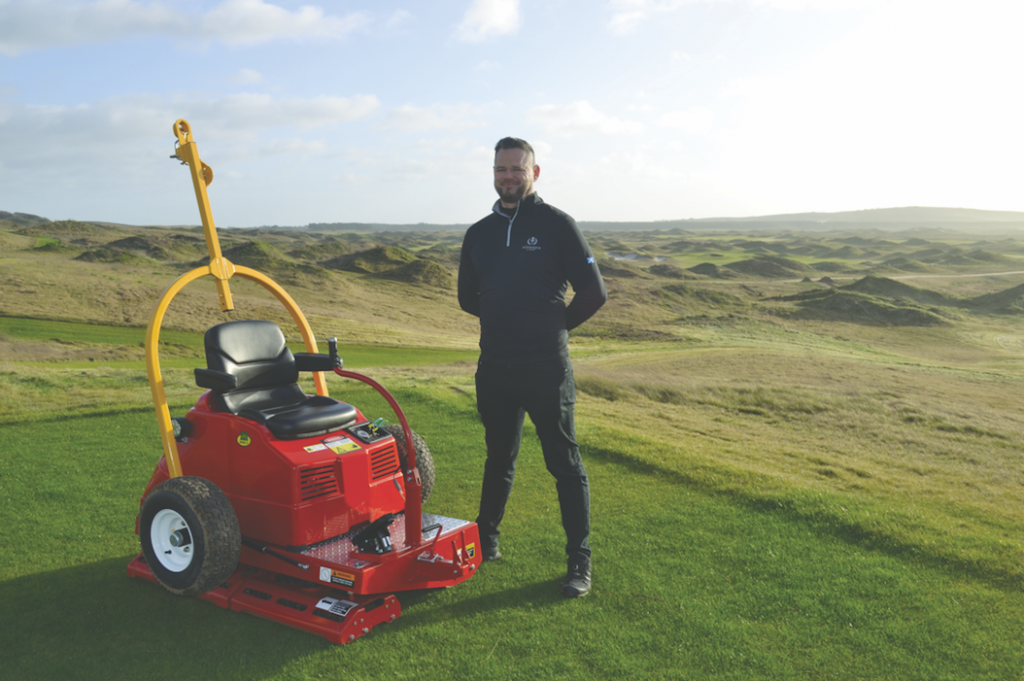
Your current position sees you take in far more responsibility than solely the course, how have you been instrumental in the development of the new ‘Agronomy Facility’ and what is unique about it, and what further development and project management responsibilities do you currently carry?
Being involved with the Agronomy Facility from the very start is a real privilege.
Having an input with the design of every respect of the building will make sure our work is carried out just as I plan it when we are fully operational in May 2020.
Apart from managing the golf course I am also responsible for project managing entry walls, the entry road, the car park and landscaping, railway sleeper works, the starter hut and surrounding areas of the clubhouse, which will all need to be tied in and looking pristine for May 16.
I am also representing OB Sports regarding the clubhouse build and I am heavily involved with this project.
How do you communicate with the management chain and board given they are based in the US, what are the expectations of you and how do you manage these together with overseeing everything else that is going on daily?
My direct line of communication is with Luke Beardmore, senior vice president of OB Sports Golf Management. OB Sports are responsible for managing Dumbarnie Links. I have a great working relationship with Mr Beardmore and we communicate regularly via text, emails and frequent phone calls. We speak on the telephone multiple times per week to stay on top of all things Dumbarnie. Expectations are very high but I believe staying as organised as possible is critical to having a successful day.
The pressures on the course manager to deliver a better product are growing year on year and the level of professionalism is rising with this. What do you think are the qualities now needed to meet the requirements and demands of golfers by someone in your position and how does this help contribute to the business of golf?
I only see the level of professionalism rising as a positive for our industry. I personally love trying to achieve the highest possible standards for the course and the staff. As long as the golfers stay realistic to budgets available of course.
What currently gives you the greatest satisfaction from your job; how do you feel daily when you are moving around Dumbarnie Links viewing what you and the team have so far accomplished?
Looking at the course now, it does tell me we have been really successful growing in the course so quickly, but as a course manager I am constantly planning ahead to the next task to keep the overall project moving forward.
Moving around Dumbarnie fills me with pride at the high standards we as a team have achieved since construction began in summer 2018.
What are the most memorable things you have been taught in your career and by whom, and with your years of experience, what advice would you give to youngsters starting out and wanting to pursue a career in the profession?
I have worked under some top course managers and learned many different skills. I was once told ‘there is always a solution to a problem, you just have to find it’. I like to pass this on to my team. As a youngster I was told to look tenacious and have a good attitude.
My passion for the course was always there and I see the condition of the course as a reflection of my work.
If you are prepared to work hard, greenkeeping is a great career and I cannot imagine doing anything else.
What changes do you think need to be made to benefit the industry sector and profession of the greenkeeper?
I would love to see far more younger people coming into the industry, there seems to be lack of staff available at the moment. Hopefully this situation can improve if we all encourage people to give greenkeeping a try.

























